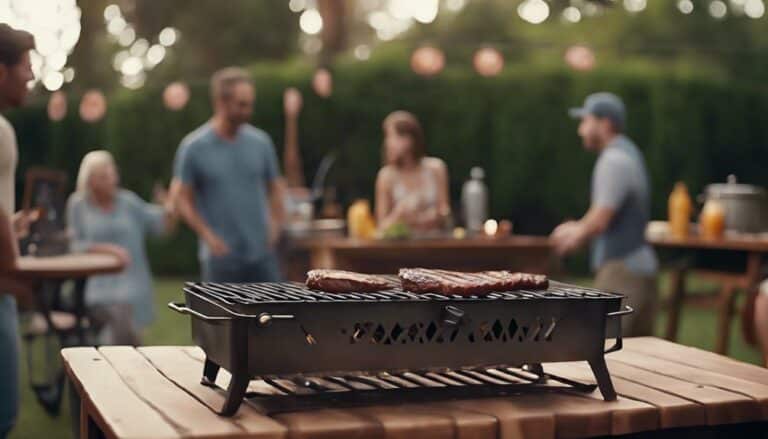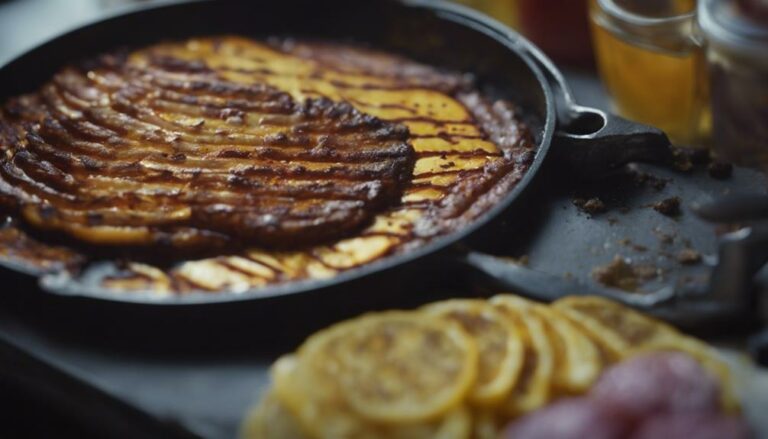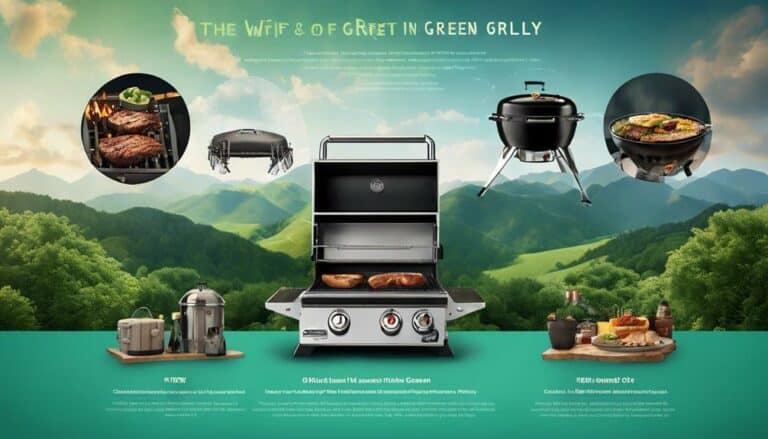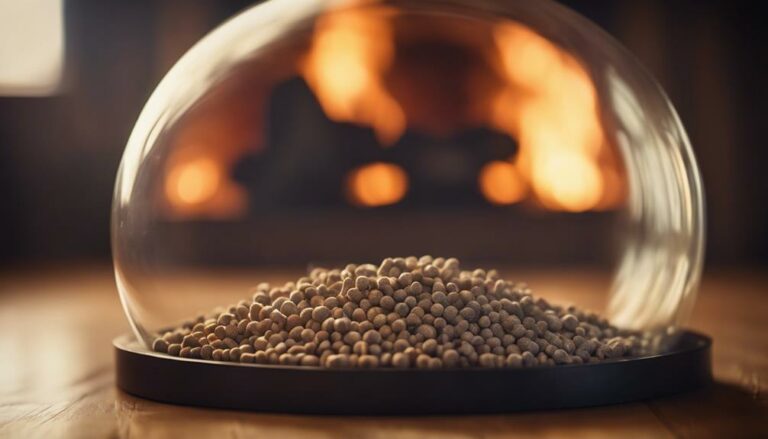As a passionate griller, I’m always on the lookout for ways to make my barbecues safe and fun. BBQ Safety 101 is an essential guide to help you grill without risks.
In this article, I’ll cover everything you need to know, from checking the grill and equipment, to safe cooking practices, to storing and cleaning the grill.
Let’s get started and stay safe!
Table of Contents
Key Takeaways
- Thoroughly check for signs of wear or damage and follow a checklist of maintenance items before each grilling session
- Choose a safe location for the grill, considering weather conditions, fire safety, and wind direction
- Use the appropriate fuel choice (charcoal, propane, or natural gas) and follow the manufacturer’s instructions for safe grilling
- Practice safe cooking practices, including keeping utensils clean, monitoring grill heat, and cooking food thoroughly to the recommended internal temperature

Check the Grill and Equipment
Giving my grill and equipment a thorough check is essential for safe grilling. I make sure to check for any signs of wear or damage that could be dangerous. A checklist of maintenance items to check before every grilling session is a must.
I look for loose connections and check for any gas or propane leaks. I also check the grill temperature to make sure it’s at a safe level. I use a thermometer to ensure the temperature is consistent throughout the cooking process.
Safety is my number one priority, so I’m always sure to double-check my grill and equipment before each use.
Prepare the Grill
Before I fire up the grill, I make sure it’s properly prepared. This includes:
- Assembling the grill properly according to the manufacturer’s instructions.
- Checking the fuel storage for leaks or damage.
- Tightening all loose connections and screws, and cleaning the cooking grates.
- Inspecting the grill for any damage or rust that could impact its performance.
Taking the time to prepare the grill properly helps create a safe and enjoyable grilling experience. By following the manufacturer’s instructions and performing a thorough inspection, I can ensure that my grill is safe and ready to go.
Setting Up the Grill
Before you can start grilling, it’s important to consider the location, fuel choice, and ventilation.
I’m passionate about grilling safely, so I always take time to set up my grill correctly.
I’m sure you’ll find the same satisfaction in preparing for a great grilling experience.
Location Selection
Choosing the right location for grilling is essential for safe barbecuing. When selecting a spot, take into account the weather conditions, fire safety, gas lines, and wind direction. Here are a few key considerations to keep in mind:
- Weather: Avoid grilling in wet or windy conditions.
- Fire Safety: Make sure the grill is placed far away from combustible items, and never leave the grill unattended.
- Gas Lines: Keep the grill away from the gas lines and other utilities.
- Wind Direction: Avoid grilling in an area where the wind is blowing directly towards your home or neighbors’.
Grilling is a fun activity to enjoy with family and friends, so always make safety your top priority.
Fuel Choice
When it comes to fuel choice, I’m partial to charcoal for its smoky flavor, but propane or natural gas are also popular options.
Charcoal requires a bit more effort and preparation, but it’s worth it for the flavor.
On the other hand, gas grills are easy to use and maintain, plus they provide consistent heat.
When it comes to propane, it’s important to be aware of the hazards of using it. Make sure to check the propane tank for any holes, leaks, or dents, as these can cause a fire hazard.
Always keep the propane tank away from the heat and never store it indoors.
Lastly, make sure to read the instructions on your grill to ensure safe grilling.
Ventilation
It’s important to ensure proper ventilation when grilling to prevent combustion and smoke-related health issues. Here are some quick tips to keep in mind:
- Check the grill for any obstructions that block airflow and cause carbon monoxide buildup.
- Keep the grill away from windows, doorways, and overhangs where the smoke can linger.
- When using a charcoal grill, make sure the vents are open so the smoke can escape.
- If possible, set up the grill in an open space away from any walls or buildings.
Monitor the airflow around the grill, and adjust the vents and fan as needed to ensure the smoke is able to escape. Proper ventilation is key for safe grilling.
Safe Cooking Practices
I’m all about grilling safely!
Practicing safe cooking is essential to a successful and enjoyable grilling experience.
That’s why it’s important to:
- Keep your utensils clean
- Wear gloves while handling hot surfaces and food
- Carefully monitor the heat of your grill.
Cleaning Utensils
Cleaning grilling utensils is important for safe barbecuing. After each use, it’s imperative to clean the grill and the utensils properly. Here are a few tips to keep in mind:
- Scrape off the residue: Take a metal spatula or brush and scrape off the food residue that’s stuck on the cooking grates.
- Scrub clean: Using hot water, a sponge, and a mild soap, scrub the grill and utensils to remove any remaining debris.
- Rinse off: Rinse off the grill and utensils with a hose or a spray bottle to make sure there’s no soap residue left.
- Dry off: Dry off the grill and utensils with a clean cloth or towel to prevent rusting.
Following these steps is key to maintain a good grilling technique and food hygiene. Doing so will help keep the food safe and free from bacteria. Plus, it will also ensure that your food tastes great every time you grill!

Wearing Gloves
Wearing gloves while grilling is an important part of keeping food safe and hygienic. Grillers should choose a glove type that is heat-resistant, durable, and resistant to punctures or tears. When selecting the size, make sure the gloves fit snugly so that the griller has maximum dexterity and control. The table below outlines some of the key considerations when selecting the right glove.
| Key Consideration | Key Suggestion |
|---|---|
| Glove Type | Choose heat-resistant, durable, and puncture-resistant |
| Glove Fit | Choose a size that fits snugly on the hand |
| Design | Look for gloves with a textured surface to prevent slipping |
When wearing gloves, it is important to change them regularly and between tasks. This helps to reduce the risk of cross-contamination and foodborne illnesses. Grillers should also remember to use separate utensils when handling cooked and uncooked food. Following these safety tips can help ensure everyone enjoys a safe and delicious barbecue.
Monitoring Heat
When it comes to grilling, monitoring the heat is essential for safety. Using the right tools can make a huge difference in ensuring your BBQ is safe. Here are some of the things I like to use to monitor heat while grilling:
- Meat thermometers: These are a must-have! With a thermometer, you can make sure your meats are cooked to the right temperature and avoid any food-borne illnesses.
- Fire prevention: Keep a fire extinguisher nearby in case of any flare-ups. Also, keep an eye on the flames and make sure they don’t get too out of control.
- Grill thermometer: If you’ve a charcoal or gas grill, you should use a grill thermometer to make sure the heat is just right.
- Timer: A timer is always useful for keeping track of cooking time. This will ensure that your food doesn’t burn or get cooked too long.
Storing and Cleaning the Grill
- I always make sure to store my grill properly and keep it clean.
- After grilling, I make sure to cool the grill down before I store it away.
- I use the right cleaning supplies and a stiff brush to scrub away any food residue that’s left behind.
- I make sure to keep the vents of the grill free from any debris.
- I always make sure to keep the grill in a safe, dry place when it isn’t in use.
- I also make sure to cover the grill with a waterproof cover to protect it from the elements.
- I also make sure to inspect the grill for any damage before I store it away.
Additional Safety Tips
Before grilling, I always take the necessary precautions to ensure I’m doing so safely. Here are a few tips to consider:
- Always check the grill maintenance before and after grilling to make sure it’s functioning properly.
- Use separate cutting boards and utensils for raw and cooked food.
- Store food properly and keep it away from other items.
- Avoid cross-contamination by washing hands and surfaces often.
Grilling can be a fun and delicious activity, but it’s important to follow safety measures to avoid potential risks. By taking the time to do a little bit of grill maintenance and practice proper food storage, I’m able to enjoy a great meal without any worries.
Frequently Asked Questions
What Is the Best Type of BBQ Grill to Use?
When considering charcoal vs. gas for a BBQ grill, I prefer charcoal as it offers more control over the temperature and fuel sources. It also adds smoky flavor that’s hard to replicate with gas.
How Long Should I Leave the Grill on For?
When grilling, cooking times depend on the heat distribution of the grill. Always use a thermometer to ensure the temperature is correct and leave the grill on for the appropriate amount of time.
Is It Safe to Leave a BBQ Grill Outside in Bad Weather?
Storing a grill outside can be risky in bad weather. Wind protection should be considered, and rain can cause rusting. It’s best to store the grill in a shed or garage if possible. Otherwise, cover the grill and secure it to reduce wind damage.
What Is the Best Temperature to Cook Food on a BBQ Grill?
When grilling, it’s important to keep the temperature consistent to avoid flare ups. I recommend creating two heat zones: a cooler area for indirect cooking and a hotter area for direct cooking. This helps ensure food is cooked safely and evenly.
How Often Should I Clean My BBQ Grill?
I clean my grill after each use and do a deep clean monthly. Proper storage and regular grill maintenance are key to grilling safely.
Conclusion
Grilling can be a great way to cook delicious meals, but it’s important to stay safe while doing so. With the right equipment and safety practices, you can enjoy your meal without any risks.
Remember to check your grill and equipment, prepare the grill, and set it up properly. Be sure to practice safe cooking, store and clean the grill, and follow any additional safety tips to stay safe while grilling.
With a little bit of care, you can have a safe and enjoyable barbecue experience.










